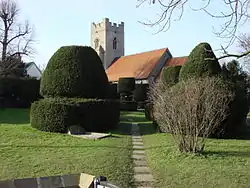Borley Church
Borley Church is the parish church in Borley, Essex. The church is in the ecclesiastical parish of Borley and Liston, one of the Fifteen Churches of the North Hinckford Benefice in the Diocese of Chelmsford of the Church of England.[1] The church is a Grade I Listed building, notable for its topiary walk and a large monument to Sir Edward Waldegrave (a member of Mary I of England's privy council) and his wife.[2]

Description and history
The church (dedication unknown) is a small building of stone; the nave may date to the 11th century. Later renovations have resulted in the mainly perpendicular style of the mid-14th to 16th centuries, still visible in the chancel and the western tower.[3] The church as it now stands consists of chancel, nave, south porch and a crenellated western tower containing three bells, two of which were cast by Alfred Bowell of Ipswich in 1926, and one from 1574 cast by S II Tonni. They hang in their original oak frame with evidence a fourth bell may once have been present. There is a topiary walk leading to the porch, with bushes once shaped like Indian chess pieces. The path use to be flag stones, however as of 2017 a new brick, wheelchair friendly path has been installed with side lights.[3] It is designated by English Heritage as a Grade I listed building.[4] Grade I is the highest of the three grades of listing, granted to buildings that "are of exceptional interest, sometimes considered to be internationally important".[5]
Not long after 1545 the manor was granted to Sir Edward Waldegrave (knighted in 1553 at the coronation of Queen Mary, died in the Tower of London on 1 September 1561) by Henry VIII. After the death of Edward, he was admitted to Queen Mary's privy council and granted the manor of Navestock, where he moved the family seat.[6] In addition Waldegrave was Master of the Wardrobe for Queen Mary and her husband, Philip II of Spain.[7]
The chancel contains a monument to John Durham of Norfolk.[8] Several tombs of the Waldegrave family are found within the structure, including a monument 14 feet high, 9 feet long, and 5 feet wide,[9] with a cornice supported by six pillars of the Corinthian order, beneath which lie full-length marble figures of Sir Edward Waldegrave and his wife Lady Frances Waldegrave née Neville (died 1599). Both tombs bear a marginal inscription in Latin and a record of other alliances of this family. On the chancel's north wall is a devotional statue of Magdala Southcote, Walgrave's daughter, who died 8 September 1598 (Nikolaus Pevsner notes it, but calls it "not good"[3]).[7] The church contains memorials to two 19th-century rectors, John Philip Herringham and his son William Herringham. John Philip was a Pembroke graduate and one of the signees of a declaration protesting the Maynooth Grant in 1845;[10] William entered Peterhouse, Cambridge.[11]
The glebe was 10 acres (4.0 ha) in the mid-19th century; in both 1821 and 1831 the parish had 195 inhabitants.[7]
References
- "Fifteen Churches of the North Hinckford Benefice in the Chelmsford Diocese". A Church Near You. Church of England. Retrieved 30 July 2020.
- Bloxam, Matthew Holbeche (1834). A Glimpse at the Monumental Architecture and Sculpture of Great Britain: From the Earliest Period to the Eighteenth Century. Pickering. p. 228.
- Pevsner, Nikolaus (1973), London, Penguin, p. 95, ISBN 978-0-14-071011-3
- Historic England, "Parish Church (Dedication unknown) (1169675)", National Heritage List for England, retrieved 20 August 2013
- Listed buildings, English Heritage, archived from the original on 24 January 2013, retrieved 20 August 2013
- Badham, Charles (1852), The history and antiquities of All saints church, Sudbury, and of the parish generally, p. 171
- Wright, Thomas (1836), The history and topography of ... Essex, pp. 556–57
- Lee, Frederick George (1875), The Christian Doctrine of Prayer for the Departed, Daldy, Isbister, p. 299
- Britton, John; Brayley, Edward Wedlake; Brewer, James Norris; et al. (1803), The Beauties of England and Wales, or, Delineations, topographical, historical, and descriptive, of each county, 5, Thomas Maiden, for Vernor and Hood, p. 372
- "Essex Clergymen Against Maynooth", The British Magazine and Monthly Register of Religious and Ecclesiastical Information, Parochial History, and Documents Respecting the State of the Poor, Progress of Education, &c, J. Turrill, 1845, pp. 56–57
- Admissions to Peterhouse Or S. Peter's College in the University of Cambridge: A Biographical Register; Being an Extract Transcription of the Entries in the College Admission Books from 1615 to 1887, Together with an Abstract of the Entries in the Academic Register from 1887 to October 1, 1911, Cambridge University Press, 1912, p. 478